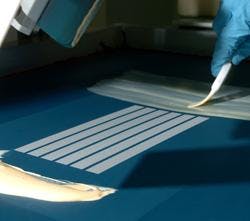Queanbeyan, Australia--Dye Sensitized Solar Cell (DSC) technology from Dyesol—primarily for building integrated photovoltaic (BIPV) applications—achieved a 7.48% optical-to-electrical power conversion efficiency at one-third Sun (typical of lower-light, real-world lighting conditions) for the 'strip cell' active area when tested by Newport Corporation's (Irvine, CA) Technology & Applications Center's Photovoltaic (TAC-PV) Laboratory. The TAC-PV Lab is accredited by the American Association for Laboratory Accreditation (A2LA) to ISO/IEC 17025, American Society for Testing Materials (ASTM) standard E948, IEC 60904-3 ed. 2, and ASTM E1021.
The Dyesol DSC technology uses biomimetic "artificial photosynthesis" whereby an electrolyte, a layer of titania (a pigment used in white paints and tooth paste), and ruthenium dye are sandwiched between glass; light striking the dye excites electrons that are absorbed by the titania to become an electric current many times stronger than that found in natural photosynthesis in plants. Compared to conventional silicon-based photovoltaic (PV) technology, Dyesol says its process has lower cost, lower-energy and lower-toxicity manufacturing requirements, and produces electricity more efficiently even in low light conditions and can be directly incorporated into buildings by replacing conventional glass panels rather than taking up roof or extra land area.
In 2008 alone, Dyesol demonstrated greater than 11% peak efficiency in converting sunlight (1 Sun) to electricity, produced multi-colored, robust, flexible cells for camouflage and security applications, and demonstrated practical application of DSC on a coiled steel coating line.
With performance confirmed and an initial proof-of-concept phase nearing completion, Dyesol's joint venture in Ohio, DyeTec Solar, expects to relocate and expand its workshop to allow Dyesol to enter the testing-validation and prototype development phase that will confirm product performance in BIPV applications. With continued Ohio Third Frontier funding, it is anticipated that the testing-validation and prototype development phase will take 12 to 18 months, during which time the DyeTec Solar team will focus on material evaluation, design, finalizing low cost manufacturing procedures, and producing a limited quantity of product.
"Dyesol scientists have been achieving very high low-light conversion efficiency performance for some time now, but getting third-party, external validation that our DSC 'strip cells' are achieving performance levels nearing seven and a half per cent in low light reinforces the extraordinary commercial potential of DSC as a green value-add technology," said Dyesol executive chairman Richard Caldwell.

